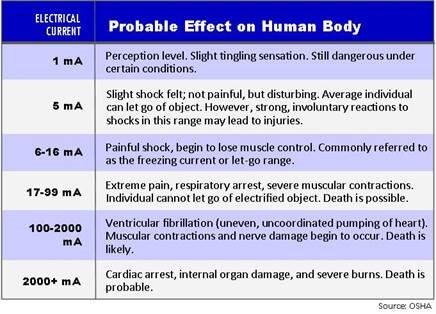What Everyone Needs to Know About Electric Shock Drowning
 In 2016, Silicon Valley executive Jim Tramel and his family were spending spring break at their vacation home in Palm Springs, California.
In 2016, Silicon Valley executive Jim Tramel and his family were spending spring break at their vacation home in Palm Springs, California.
Several family members came over to visit and enjoy the swimming pool on Easter afternoon. Jim noticed his 9-year-old daughter abruptly stop moving in the water and sink to the bottom of the pool. He jumped in to save her.
Both Jim and his daughter were pulled from the water. Cardiopulmonary Resuscitation (CPR) was administered; 911 was called. His daughter was taken to the hospital in critical condition. Unfortunately, Jim was pronounced dead.
Seven additional people were also treated for injuries. The skin of all of the swimmers had turned a blue color, accompanied by a tingling sensation, and some suffered more extensive injuries.
How Did This Tragedy Happen?
All of the swimmers were shocked by electricity from faulty pool light wiring. None of the victims directly touched the wiring, and there were no visible signs of danger. The electric current was conducted through the pool water. The further away from the source of electricity, the less severe injuries were to the swimmer.
Electrical shocks in swimming pools are rare, but tragic. The U.S. Consumer Product Safety Commission reported 60 pool-related electrocutions and 50 serious electrical shocks between 1990 and 2015.
What is Electric Shock Drowning?
Electric Shock Drowning (ESD) occurs when people swim in freshwater containing leaked electricity. Even a minor electric shock can be life-threatening, because the electric current paralyzes muscles, making it impossible to swim. Electrified water also makes it difficult for people to rescue someone without being shocked themselves.
Lethal amounts are measured in milliamps (mA), or thousandths of an amp. These tiny amounts of electricity interfere with nerves and muscles. According to Coast Guard Captain David Rifkin, “Anything above 3 mA can be very painful.”
As little as 10 mA can cause paralysis, and thus drowning. Just 100 mA – less than a third of the electricity required to light a 40-watt bulb – is almost always fatal if passed directly through the heart.
The cycling nature of alternating current (AC) disrupts the human body far more than direct current (DC). Most pool lights, pumps and other equipment employ AC, which requires four times less voltage to cause the same damage as DC.

Not Just Swimming Pools
ESD can be a risk in any freshwater environment – not just man-made swimming pools.
Over the Fourth of July weekend in 2012, 13-year-old Alexandra Anderson and her younger brother Brayden were swimming near a private dock on the Lake of the Ozarks in Missouri when they started to scream. By the time their parents pulled them from the water, they were unresponsive. Both were pronounced dead at the hospital.
120-volt AC leakage from nearby boats electrocuted the young swimmers. In a properly functioning electrical system, the current that goes into a boat through a power cord returns to its source – a transformer on shore or on the dock.
When an electrical grounding system is compromised, stray electricity has only one path back to its source – through the water. All of the boat’s underwater metals, such as the propeller, stern drive, and through-hull fittings, become energized. Electricity radiates out from these metal fittings into the water.
In freshwater, this dangerous voltage gradient will pass through a swimmer’s body, rendering the victim unable to swim to safety.
Why Freshwater?
Saltwater is 50+ times more conductive than freshwater. The human body is much more conductive than freshwater and a little less conductive than saltwater.
In saltwater, the human body slows electricity down, so most of an electric current will go around a swimmer, unless they grab hold of something electrified, such as a swim ladder. If a boat is in saltwater, stray electric current will dissipate without doing damage, unless a swimmer directly touches energized metal.
However, an electric current passing through freshwater is slower and gets stuck trying to return to its source. When it encounters a swimmer, the electricity speeds up and tries to take a shortcut through the human body.
ESD is a Silent Killer
There is no visible way to tell whether water in a pool, marina or dock is energized or safe.
Victims do not usually feel an electric current immediately when they enter the water, giving the false impression that it is safe to swim.
Electrical faults can also be intermittent, sometimes leaking deadly current into the water only when a light switch or other electrical device cycles on. Safe areas of water can reach fatal levels of electricity within a split second.
Unless there is a witness nearby to experience and report the sensation of electric shock in the water, an ESD death is usually labeled as a common drowning.
Early Signs of ESD
ESD deaths and injuries are entirely preventable, but most people have never heard of ESD and are unaware of the danger or how to help a victim effectively. If you and your family enjoy water recreation, it is important to be able to recognize the signs of ESD and understand how to respond to an ESD emergency appropriately.
Signs of early ESD include:
- tingling sensation
- muscle cramps
- feel frozen or unable to move
- numbness
- pain
- skin discoloration
If you are in the water and feel tingling:
- Get out of the water immediately, if you are able.
- Try to stay upright.
- Back out of the area the way you came. Do not swim toward the dock.
- Shout! Drowning victims cannot speak, let alone shout.
- Let everyone know what is happening, so they will understand the danger and respond appropriately.
- Warn other swimmers in the area of danger.
How to Help an ESD Victim
- Do NOT jump into the water. Many rescuers have died trying to help ESD victims.
- Call 911 for help.
- Help get the victim out of the water. Reach, throw lifesaving devices, extend a rope or non-conductive pole.
- Turn off power sources immediately.
- ESD victims are good candidates for successful CPR.
Owners of pools, docks and boats have a responsibility to maintain their equipment for the safety of others. This means routine testing, equipment updates and repairs, as well as securing potentially dangerous situations.
If you, or a loved one, has been in an ESD or water-related incident due to the negligence of another, call a personal injury attorney from the Arnold Law Firm at (916) 777-7777. Our attorneys are experienced with ESD cases and can help assess your situation.
